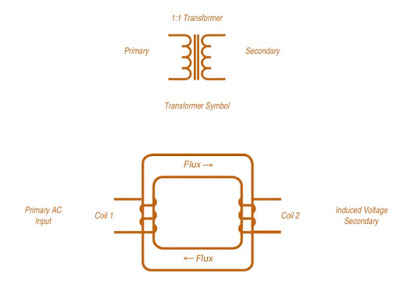Isolation Transformer:
An isolation transformer is a Transformer used to transfer electrical power from a source of alternating current (AC) power to some equipment or device while isolating the powered device from the power source, usually for safety reasons. Isolation Transformers provide galvanic isolation and are used to protect against electric shock, to suppress electrical noise in sensitive devices, or to transfer power between two circuits which must not be connected. A transformer sold for isolation is often built with special insulation between primary and secondary, and is specified to withstand a high voltage between windings.
Isolation transformers block transmission of the DC component in signals from one circuit to the other, but allow AC components in signals to pass. Transformers that have a ratio of 1 to 1 between the primary and secondary windings are often used to protect secondary circuits and individuals from electrical shocks between energized conductors and earth ground.
Suitably designed isolation transformers block interference caused by ground loops. Isolation transformers with electrostatic shields are used for power supplies for sensitive equipment such as computers, medical devices, or laboratory instruments.
Pulse Transformer:
A pulse transformer is a type of Transformer optimized and designed for transmission of voltage pulses between its windings and into the load. Pulse Transformers can be used for signal transmission, low-power control circuits, as well as the main components in high-power switched-mode power supplies.
Low-power pulse transformers are used for controlling switching elements like power semiconductors (transistors, thyristors, triacs etc.) which are connected to a different voltage level and direct driving is not possible due to unfavorable potential difference or safety implications. In such applications the name gate drive transformer is also used.
The distinction is based mostly on the actual purpose of the transformer, where the transformer is used to directly drive a transistor gate it is referred to as a gate drive transformer, if used only as a means of transmitting rectangular voltage signals then as a Pulse Transformer. The core of Pulse Transformer is made of Ferrite.
However, in a general sense a Pulse Transformer is any transformer capable of transmitting voltage pulses (often rectangular) with adequate signal fidelity.
Requirements like high-permeability core, low leakage inductance, low inter-winding capacitance etc. are common also to the power transformers in several switched-mode power supplies. Therefore, extremely high power transformers (rating MW or even TW) can be referred to as Pulse Transformers.

